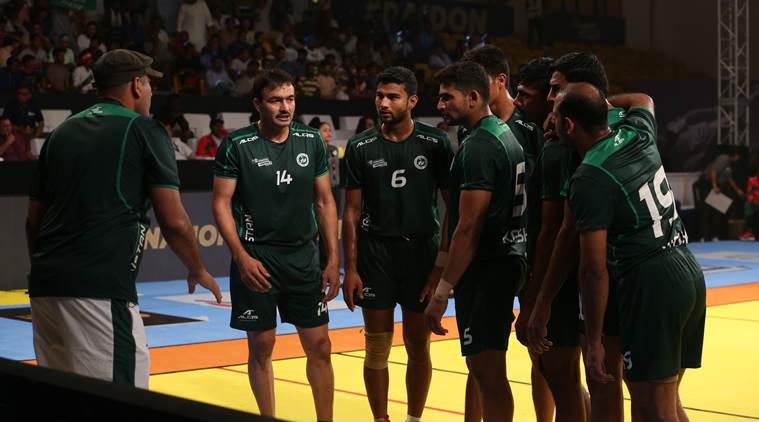 Pakistan Kabaddi team at the Kabaddi Masters Dubai 2018.
Pakistan Kabaddi team at the Kabaddi Masters Dubai 2018.
Nabeel Ahmed Rana wasn’t overawed when he first saw the flashy setup at the Al Wasl Indoor Stadium. Granted, neither he nor his players in the Pakistan kabaddi team had ever been a part of the glitzy Pro Kabaddi League in India (barring two players) – which is what the setting at the Kabaddi Masters Dubai resembled. The national coach had, after all, seen a bigger rendition of the sport back home when Pakistan launched its own Super Kabaddi League.
“Our tournament has even more lights and music and the crowd is even more noisy,” he says. “Dekhne waali cheez hai.”
For 10 days in May, 10 franchises descended upon Lahore for a breakthrough tournament that marked the re-emergence of Pakistan in the sport. The measure was needed since kabaddi descended from being a highly rated activity in the country to a fringe game that had dropped in quality.
And it was the jolt at Incheon, at the 2014 Asian Games, that the country needed to look for new measures to boost a game that was once a sure-shot medal prospect.
“India has always been the main team, but we’ve been the prime contenders for the second spot,” says former Pakistan national coach Badshah Gul, who is now an international referee. “Then Iran came and overtook us. So from silver, we went down to bronze. But at Incheon, Korea came up. So there was a fear that we might be out of the medal tally altogether if we don’t improve.”
Till date, Pakistan has two silver and five bronze medals in the seven editions of the Asian Games in which Kabaddi has featured as an event. For the upcoming Games in Jakarta though, the federation began preparing soon after the team returned with a bronze from Incheon.
“There was a meeting with the sports board that decided that any team with a medal prospect would be given full support,” says Rana. “The finances were made available to us with all the equipment we need and we started to have longer national camps.”
What was missing though was match practice.
Tensions in Pakistan rendered the country an avoidable destination for visiting teams, thus affecting the overall sporting culture. There was a simple answer to it though, but not one available for kabaddi.
“The world didn’t refuse to play against Pakistan, the world just refused to play in Pakistan,” says Gul, a winner of two silver and one bronze medal at Asian Games. “That’s why our cricket and hockey teams managed to go abroad and play and stay relevant. But that could not happen for kabaddi because the best place to play is in India and we couldn’t go there.”
No player from Pakistan plays in the PKL, and for the 2016 World Cup in Ahmedabad, organisers withdrew their invitation to the neighbours. But away from the limelight, Rana began scouting and searching for a new team.
“We’ve always been a team of strong defenders,” he says. “But now we’ve managed to get in a few good raiders as well to give it the balance.”
Quietly improving, the team travelled to Iran for the Asian Championships in November and set-up a tough clash against the hosts in the semi-final – a match Iran was expected to comfortably win.
“Iran was taking it so casually that they didn’t even do a proper warm-up,” recalls Gul. “We had four new boys in our team then and had told them to just go out and impress. They came back with a 28-24 win. That was a milestone win for us.”
The upset win in Iran brought more awareness to the game, especially since the circle-style of kabaddi is more popular there than the international style. Since players from both styles are employed with the Services, there was more scope for promotions if one played in the circular format.
That too changed however, once plans for the SKL came through. All the glamour elements were included. Cricketers such as Kamran Akmal, Salman Butt and Ijaz Ahmed served as brand ambassadors for teams, while singer Shehzad Roy – who has ventured into Bollywood as well – owns the Kashmir Jaanbaaz franchise.
The most expensive players got Rs 2 lakh while the rest got Rs 1 lakh – humble beginnings compared to the PKL. But importantly, a beginning.
In Dubai, Rana has brought with him a fresh team he hopes can earn as much experience as possible before the Asian Games. But he has a further 40 players who can make the team back home.
It’s a promising result so far to the rebuilding process that began four years ago. Back home, the sport has found a new and exciting avatar. But at the Asian level, a fallen giant is looking to re-emerge.